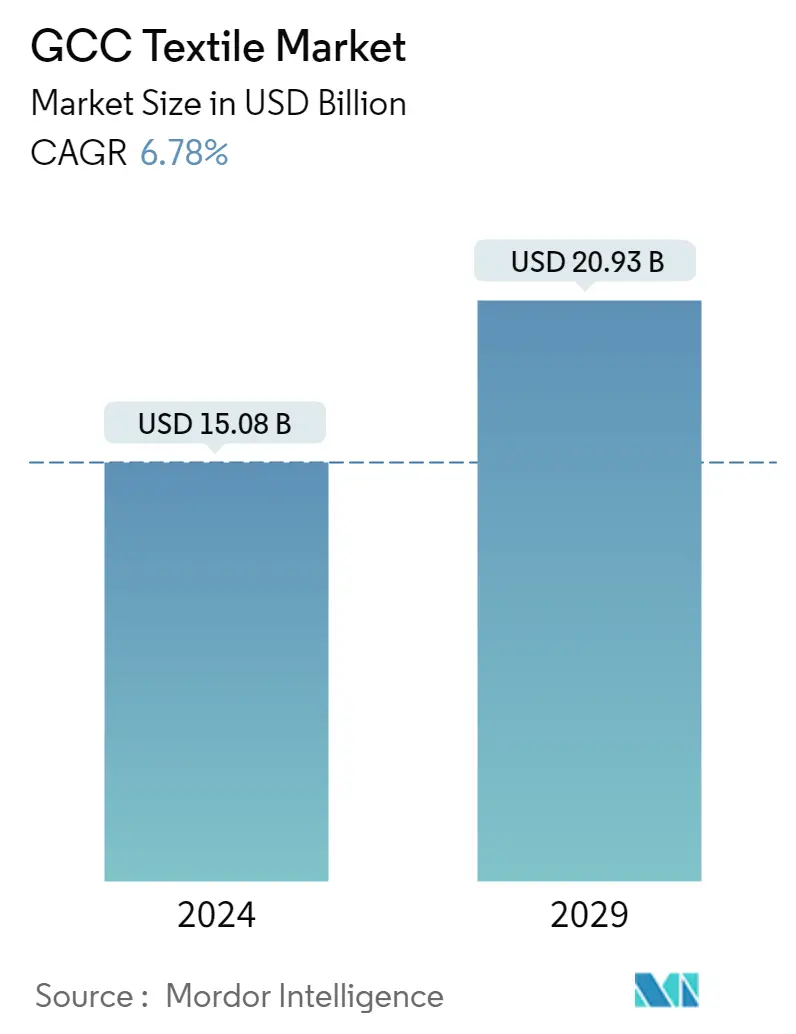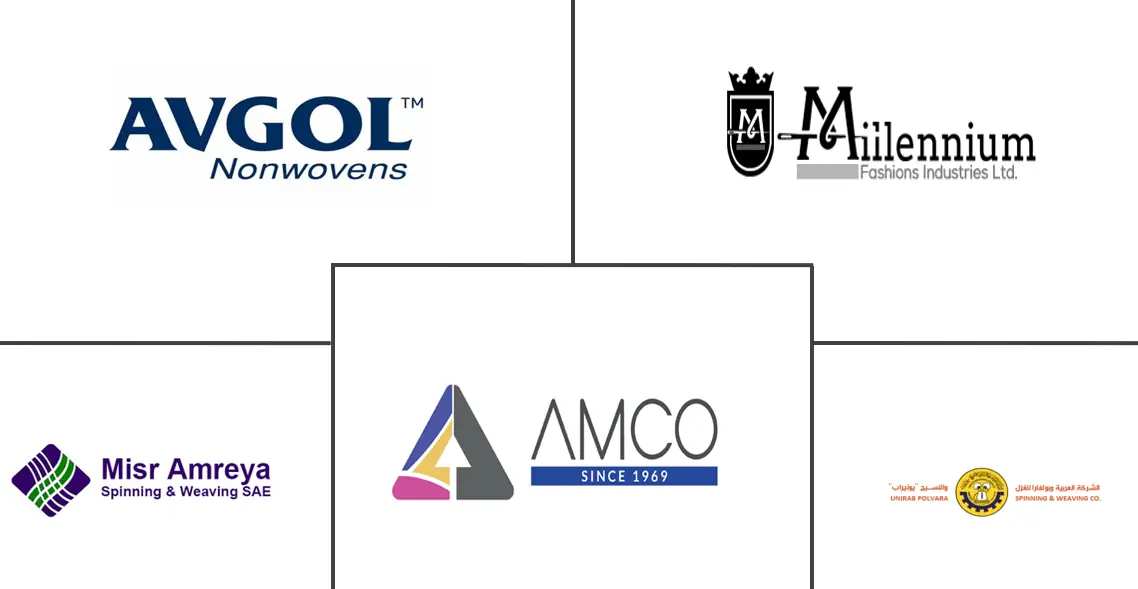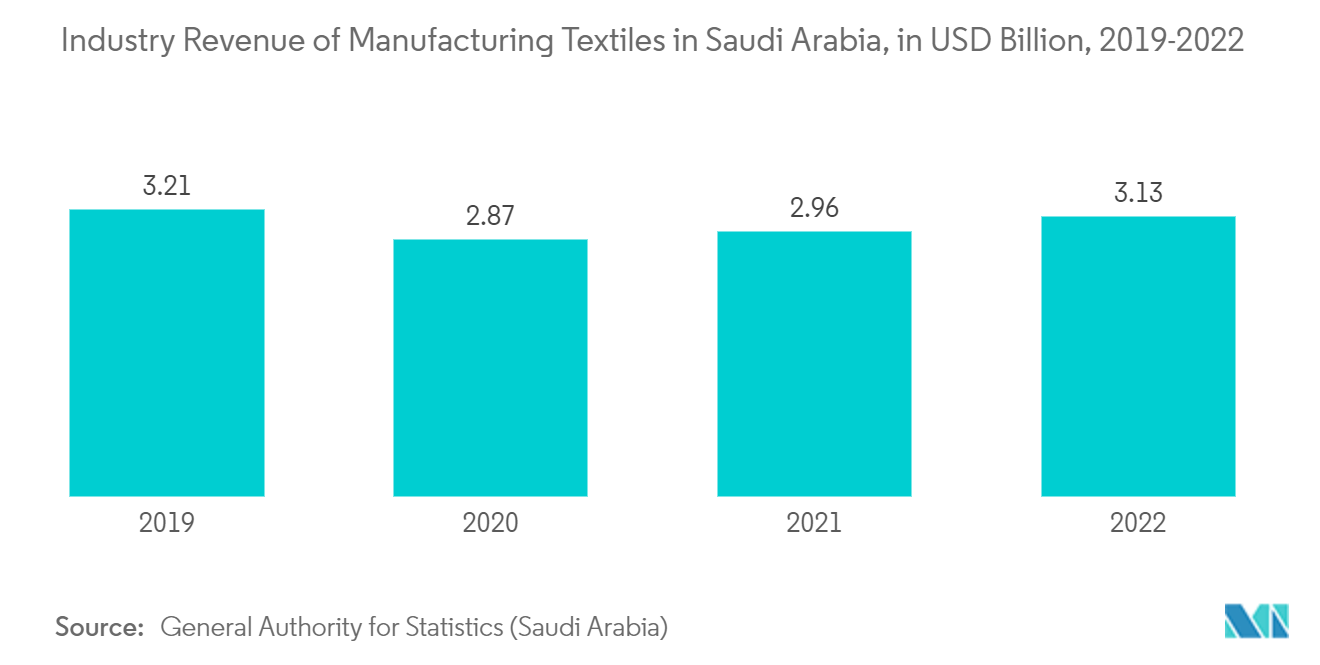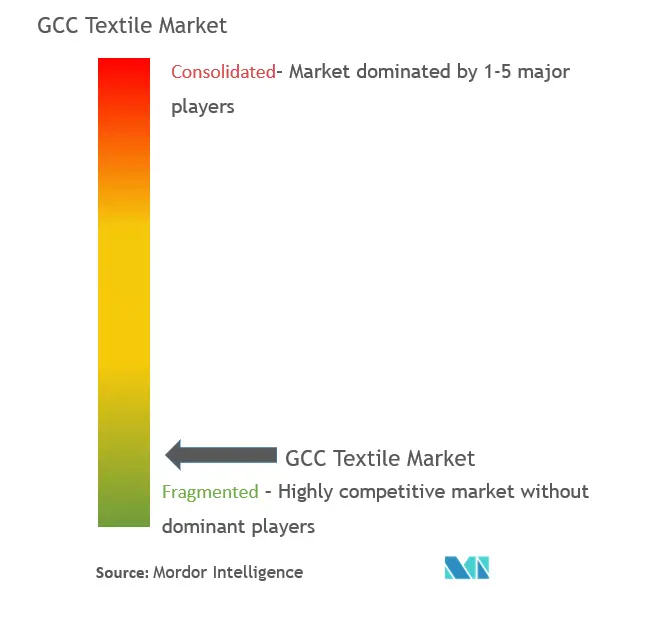GCC Textile Market Size

| Study Period | 2020 - 2029 |
| Base Year For Estimation | 2023 |
| Market Size (2024) | USD 15.08 Billion |
| Market Size (2029) | USD 20.93 Billion |
| CAGR (2024 - 2029) | 6.78 % |
| Market Concentration | Medium |
Major Players
*Disclaimer: Major Players sorted in no particular order |
GCC Textile Market Analysis
The GCC Textile Market size is estimated at USD 15.08 billion in 2024, and is expected to reach USD 20.93 billion by 2029, growing at a CAGR of 6.78% during the forecast period (2024-2029).
- In GCC, the United Arab Emirates (UAE) has a large textile industry, making products such as child safety seats, curtains, luggage, and some high-end fashion for local purchases. However, its best-selling textiles are woven goods like knitwear. This textile industry's contribution to the country's income and employment is second only to the oil and gas industry. Although the UAE sells to over 50 countries, it also has a large customer base domestically.
- The textile business in Dubai benefits retailers who want to design and sell clothing in the apparel industry and investors who wish to construct facilities to produce textile goods like clothing. Dubai has around 16 million foreign visitors annually, and the country's tourism industry is driving growth in the retail industry. Due to this, Dubai now accounts for more than 10% of the country's national gross domestic product, and the city's retail and tourism industries contribute a major chunk to the city's GDP.
- An effort to make the fashion business more sustainable and ecologically friendly has become a major trend in the world of fashion. This has motivated several designers to produce ready-to-wear garments using recycled fabrics. Saudi Arabia's brand Glamming Sisters established an eco-friendly streetwear line to promote the adoption of ethical fashion to promote and increase the adoption of sustainable fashion. The online retailer wants to provide eco-friendly modern clothing that will influence the fashion scene in the Kingdom and give customers trendy designs with a comfortable fit.
- Developments in end-user segments, for instance, residential and commercial (hospitality), and the increasing attentiveness regarding altering inclinations of home-based interior decoration are expected to motivate the home textile industry in Saudi Arabia. The rising rate of urbanization and improved quality of living are responsible for the growing demand for home textiles like bedding, bed sheets, towels, blankets, and covers.
GCC Textile Market Trends
Rising Textile and Apparels Demand in UAE
The UAE textile industry is thriving on supportive government initiatives regarding infrastructure development, tax exemptions, and transparency in paperwork. The most recent development in the fashion frontier has set Dubai as a fashion hub in 2020. The Dubai Design & Fashion Council is a governmental entity established to develop and nurture a sustainable design industry in Dubai while enabling the growth and recognition of designers based in the UAE and MENA region.
The existence of an ever-booming economy for luxury clothing has made UAE an important center for the apparel and textile businesses. The country has become a major textile hub that includes fibers, fabrics, clothes, outerwear, home textiles, and technical textiles. An increase in labor costs has led to automation in the textile and apparel industries. Development of technical textiles and providing innovative textile products are the focus areas of UAE manufacturers. This will increase productivity, improve the quality of products, and aid in delivering timely shipments of orders.
The UAE is becoming an ideal destination for investment in the textile and apparel industries due to its lack of restrictions on profit, competitive labor costs, extremely low import duty, and low corporate taxes. The availability of highly skilled and productive workers, a stable economy, and the absence of hidden costs add to the country's textile environment.

Changing Consumer Buying Patterns in GCC Countries
Technology plays a pivotal role in the lives of youthful consumers. From Facebook to Instagram, the Arab Gen Y population expects luxury brands to be online and easily available. More than 30% of the consumers in the GCC region shop online in a month primarily due to ease of access. With millennials driving the region's connectivity and mobile phone usage, the GCC is considered to have a strong foundation to adapt to the expansion of online shopping. According to a survey, since the pandemic, 89% of customers in the UAE and 91% of customers in the Middle East and North Africa became digital converts and intend to continue buying everything online.
As of 2021, the total e-commerce sales in the UAE reached just over USD 5 billion in 2021, and it is projected to cross USD 8 billion by 2025. The report found that more consumers in the UAE made online purchases across all categories during 2021 compared to 2020, with an average of 75% of respondents typically purchasing online. Similarly, in KSA, revenue in the e-commerce market is projected to reach USD 12.2 billion in 2022.

GCC Textile Industry Overview
The GCC Textile Market is fragmented and competitive, with several small, medium, and large regional players. Some of the key players in the market include Embee Group, Unirab Polvara, Misr, Amreya, Avgol, and Kabale. Manufacturers in the region are adopting new technologies and using new innovative methods, such as 3D cotton textiles and other materials like nylon and synthetic fibers, to attract consumers. Players are also adopting using recycled and sustainable materials that are cost-effective and use fewer natural resources.
GCC Textile Market Leaders
-
Unirab Polvara
-
Misr Amreya
-
Avgol
-
AMCO
-
Millennium Fashion Industries
*Disclaimer: Major Players sorted in no particular order

GCC Textile Market News
- Febuary 2023, Saudi’s MODON announces USD 1.1bn textile investments. These investments are distributed over 125 industrial contracts in 19 industrial cities, covering a total area of more than one million square meters. According to Al-Argoubi, the textiles and men’s supplies sector is experiencing high growth in the Kingdom.
- October 2022 - Nykaa enters the Gulf nations through its first global partnership with Apparel Group. The Apparel Group of Dubai will hold 45% of the company's shares, while Nykaa will control 55% of the partnership's shares. The Indian cosmetics and clothing store Nykaa recently announced a partnership with the Apparel Group, a fashion and lifestyle retailer with headquarters in Dubai, to expand its presence in the GCC (Gulf Cooperation Council) nations.
GCC Textile Market Report - Table of Contents
1. INTRODUCTION
- 1.1 Study Deliverables
- 1.2 Study Assumptions
- 1.3 Scope of the Study
2. RESEARCH METHODOLOGY
- 2.1 Analysis Methodology
- 2.2 Research Phases
3. MARKET INSIGHTS AND DYNAMICS
-
3.1 Market Dynamics
- 3.1.1 Market Drivers
- 3.1.1.1 Growing fashion consciousness
- 3.1.1.2 Export Opportunities
- 3.1.2 Market Restraints
- 3.1.2.1 Intesnse Competition
- 3.1.2.2 Raw material Price volatility
- 3.1.3 Market Opportunities
- 3.1.3.1 Technological Advancement
-
3.2 Industry Attractiveness - Porter's Five Forces Analysis
- 3.2.1 Threat of New Entrants
- 3.2.2 Bargaining Power of Buyers/Consumers
- 3.2.3 Bargaining Power of Suppliers
- 3.2.4 Threat of Substitute Products
- 3.2.5 Intensity of Competitive Rivalry
- 3.3 Value Chain / Supply Chain Analysis
- 3.4 Government Regulations and Initiatives
- 3.5 Technological Snapshot
- 3.6 Impact of COVID-19 on the Market
4. MARKET SEGMENTATION
-
4.1 By Application
- 4.1.1 Clothing
- 4.1.2 Industrial/Technical Applications
- 4.1.3 Household Applications
-
4.2 By Material Type
- 4.2.1 Cotton
- 4.2.2 Jute
- 4.2.3 Silk
- 4.2.4 Synthetics
- 4.2.5 Wool
-
4.3 By Process
- 4.3.1 Woven
- 4.3.2 Non-woven
5. COMPETITIVE LANDSCAPE
- 5.1 Market Concentration Overview
-
5.2 Company Profiles
- 5.2.1 Unirab & Polvara Spinning Weaving & Silk
- 5.2.2 Misr Amreya
- 5.2.3 AMCO
- 5.2.4 Avgol
- 5.2.5 Millennium Fashions Industries
- 5.2.6 Embee Group
- 5.2.7 Kabale
- 5.2.8 FPC Coated Technical Textiles
- 5.2.9 Alyaf Industrial Company Ltd.
- 5.2.10 Aratex Group
- 5.2.11 Lomar Selection
- 5.2.12 Valleystar Uniforms*
- *List Not Exhaustive
6. MARKET OPPORTUNITIES AND FUTURE TRENDS
7. APPENDIX
** Subject To AvailablityGCC Textile Industry Segmentation
Textiles are materials or fabrics that are made of tiny fibers that can be natural or man-made, and those fibers are then twisted into yarns. Textiles are created by interlocking these yarns in specific patterns, resulting in a length of cloth. Textiles can be classified as natural textiles and synthetic textiles. The GCC Textile Market is segmented by application (Clothing, Industrial/Technical, and Household), by material type (Cotton, Jute, Silk, Synthetics, and Wool), and by process (Woven and Non-Woven). The report offers the market size and forecasts for the GCC textile market in value (USD billion) for all the above segments.
| By Application | Clothing |
| Industrial/Technical Applications | |
| Household Applications | |
| By Material Type | Cotton |
| Jute | |
| Silk | |
| Synthetics | |
| Wool | |
| By Process | Woven |
| Non-woven |
GCC Textile Market Research FAQs
How big is the GCC Textile Market?
The GCC Textile Market size is expected to reach USD 15.08 billion in 2024 and grow at a CAGR of 6.78% to reach USD 20.93 billion by 2029.
What is the current GCC Textile Market size?
In 2024, the GCC Textile Market size is expected to reach USD 15.08 billion.
Who are the key players in GCC Textile Market?
Unirab Polvara, Misr Amreya, Avgol, AMCO and Millennium Fashion Industries are the major companies operating in the GCC Textile Market.
What years does this GCC Textile Market cover, and what was the market size in 2023?
In 2023, the GCC Textile Market size was estimated at USD 14.12 billion. The report covers the GCC Textile Market historical market size for years: 2020, 2021, 2022 and 2023. The report also forecasts the GCC Textile Market size for years: 2024, 2025, 2026, 2027, 2028 and 2029.
GCC Textile Fabric Industry Report
Statistics for the 2024 GCC Textile market share, size and revenue growth rate, created by Mordor Intelligence™ Industry Reports. GCC Textile analysis includes a market forecast outlook to for 2024 to 2029 and historical overview. Get a sample of this industry analysis as a free report PDF download.



